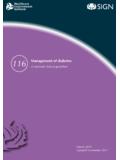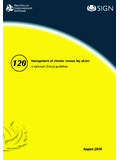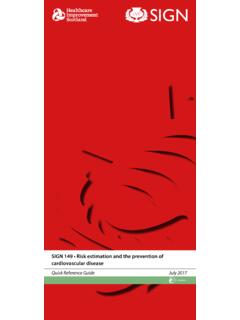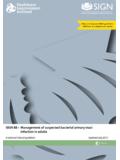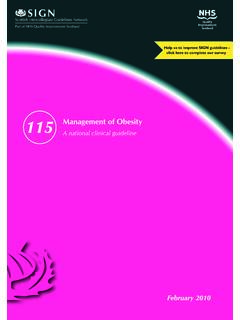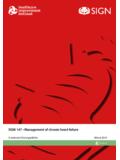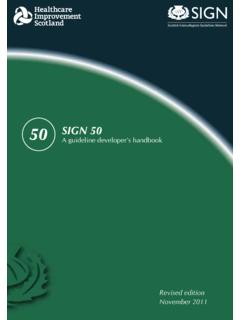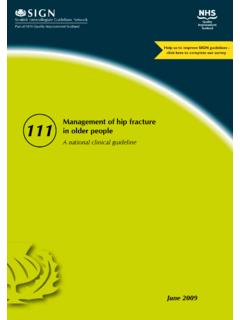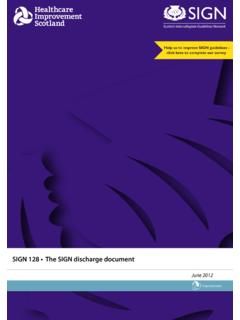Transcription of SIGN
1 ISBN 978 1 905813 69 8 Scottish Intercollegiate Guidelines Network Elliott House8-10 Hillside CrescentEdinburgh EH7 5EA and management of venous thromboembolismQuick Reference GuideDecember 2010 Scottish Intercollegiate Guidelines NetworkPart of NHS Quality Improvement ScotlandS I G N122 This Quick Reference Guide provides a summary of the main recommendations in sign 122 Prevention and management of venous thromboembolism. Recommendations are graded A B C D to indicate the strength of the supporting evidence. Good practice points are provided where the guideline development group wishes to highlight specific aspects of accepted clinical of the evidence supporting these recommendations can be found in the full guideline, available on the sign website: 978 1 905813 69 8 First published December 2010 Scottish Intercollegiate Guidelines Network Elliott House, 8-10 Hillside Crescent, Edinburgh EH7 5EA Prevention and management of venous thromboembolism quick reference guide 1 RISK FACTORS FOR VENOUS THROMBOEMBOLISMAge: <40 years annual incidence of 1/10,000, 60-69 years annual incidence of 1/1,000, >80 years annual incidence of 1/100 Obesity: 2 to 3-fold risk if BMI >30 kg/m2 Varicose veins: to risk after major general/orthopaedic surgeryFamily history of VTET hrombophiliasOther thrombotic states.
2 Cancer, heart failure, recent myocardial infarction/stroke, metabolic syndrome, severe acute infection, chronic HIV infection, inflammatory bowel disease, nephrotic syndrome, myeloproliferative disease, paraproteinaemia, Bechet s disease, paroxysmal nocturnal haemoglobinuria, sickle cell trait and sickle cell diseaseCombined oral contraceptives: 3 to 6-fold increased riskOral oestrogen hormone replacement therapy: increased risk Raloxifene and tamoxifen: 2-3-fold increased riskPregnancy: 10-fold increased risk compared with non-pregnantPuerperium: 25-fold increased risk compared with non-pregnant/non-puerperalImmobility: 10-fold increased risk with bed rest >3 days, plaster cast, paralysisImmobility during travel: 2 to 3-fold increased riskHospitalisation: 10-fold increased riskAnaesthesia: 2 to 3-fold increased risk of postoperative VTE in general compared with spinal/epiduralCentral venous catheters: femoral route increased risk compared with subclavian accessRISK FACTORS FOR RECURRENT VENOUS THROMBOEMBOLISM (in patients not on long term anticoagulation)Previous unprovoked VTE: recurrence rate 5% per yearMale sexObesityThrombophilias: risk of recurrence may be increased in patients with antithrombin deficiencyAll patients admitted to hospital or presenting acutely to hospital should be individually assessed for risk of VTE and bleeding.
3 The risks and benefits of prophylaxis must be discussed with the patient. DThe use of a risk assessment method checklist is recommended for this assessment should be repeated regularly and at least every 48 laboratory screening for thrombophilias is not is a multicausal disease, the result of the coincidence of several risk factors which can be grouped as: inherent to the individual and may be inherited, eg thrombophilia inherent to the individual and can be acquired, eg obesity, cancer and certain drug use (eg oral contraceptive pill) the result of an intercurrent illness or procedure, or other cause of temporary reduced mobility, eg following major trauma or surgery, serious medical disorder, pregnancy, or long-haul OF RISK FOR VENOUS THROMBOEMBOLISM 2 Prevention and management of venous thromboembolism quick reference guideEarly mobilisation and leg exercises should be encouraged in patients recently immobilised.
4 RATIONALE FOR PROPHYLAXISG eneral measuresThe rationale for prophylaxis is based on its efficacy, the clinically silent nature of VTE, its high prevalence in hospitalised patients, pregnant or puerperal women, and its potentially disabling or fatal consequences. There is evidence that routine prophylaxis reduces morbidity, mortality and costs in hospitalised patients at risk of deep vein thrombosis and pulmonary for asymptomatic DVT, and its treatment, is insensitive and not cost effective compared to routine prophylaxis in at-risk hydration should be ensured in immobilised patients. THROMBOPROPHYLAXIS IN SURGICAL PATIENTSG eneral surgeryPatients undergoing abdominal surgery who are at moderate to high risk should receive thromboprophylaxis with mechanical methods unless contraindicated and either subcutaneous low molecular weight heparin, unfractionated heparin or stockings are recommended for prophylaxis in surgical patients, in the absence of contraindications.
5 AIntermittent pneumatic compression devices are recommended for prophylaxis of DVT in surgical patients undergoing abdominal surgery AES can be used alone when pharmacological agents are contraindicated, for example due to high bleeding is not recommended as the sole pharmacological agent for VTE prophylaxis in surgical patients, as other available agents are more surgeryPatients undergoing total hip or total knee replacement surgery should receive pharmacological prophylaxis (with LMWH, fondaparinux, rivaroxaban or dabigatran) combined with mechanical prophylaxis unless prophylaxis should be considered. AAs other agents are more effective for prevention of DVT, aspirin is not recommended as the sole pharmacological agent for VTE prophylaxis in orthopaedic with increased risk of bleeding should be given mechanical prophylaxis the bleeding risk has become acceptable then pharmacological prophylaxis should be foot pumps can be considered for prophylaxis as an alternative to IPC in orthopaedic surgery Prevention and management of venous thromboembolism quick reference guide 3 Cardiothoracic surgeryPatients undergoing thoracic surgery should be offered mechanical prophylaxis with IPC or undergoing thoracic surgery who are not at high risk of bleeding should be offered pharmacological thromboprophylaxis with UFH or LMWH in addition to mechanical undergoing coronary artery bypass graft surgery should be offered mechanical thromboprophylaxis where undergoing
6 Coronary artery bypass graft surgery who are not at high risk of bleeding can be offered pharmacological thromboprophylaxis with UFH or LMWH in addition to mechanical IN MEDICAL PATIENTSA cute strokeWhen the assessment of risk favours use of thromboprophylaxis, UFH, LMWH or fondaparinux should be administered. AAspirin is not recommended as the sole pharmacological agent for VTE prophylaxis in medical should not be used routinely in stroke patients with non-haemorrhagic stroke at high risk of VTE, LMWH can be with cancer are generally at high risk of VTE and should be considered for prophylaxis with LMWH, UFH or fondaparinux whilst AND THE PUERPERIUMAll women should be assessed for risk factors for VTE when booking for antenatal care and at each subsequent maternity thromboprophylaxisWomen with a previous unprovoked VTE; or VTE linked to oestrogen (including pregnancy); or minimally provoked VTE (related to travel); or previous recurrent VTE; or other additional risk factors for VTE.
7 Should be offered antenatal thromboprophylaxis with considered to be at high risk of VTE because of multiple risk factors (three or more) should be offered thromboprophylaxis with LMWH antenatally (first trimester).DVitamin K antagonists have adverse fetal effects and should generally be avoided in pregnancy. In women with mechanical heart valves, however, the risks and benefits of VKA and heparin should be assessed on an individual of childbearing age using VKA should be clearly informed of the risk of teratogenesis associated with these agents and should be advised to seek appropriate medical advice if they are planning to become pregnant or as soon as possible (and within two weeks following a first missed period) if they suspect that they may be women considered to be at increased risk of VTE should be advised to wear AES when of IPC should be considered during hospitalisation in patients with acute stroke, if Prevention and management of venous thromboembolism quick reference guidePostnatal thromboprophylaxisTRAVEL-RELATED THROMBOSISAll women should be assessed after delivery for risk factors for with multiple risk factors for VTE should be considered for postnatal women who have had an emergency Caesarean section and those who have an elective Caesarean section who have one or more additional risk factors for VTE.
8 Should receive thromboprophylaxis with LMWH for seven with a previous VTE should receive LMWH for six weeks following receiving prophylaxis antenatally should continue thromboprophylactic doses for six weeks following delivery. DThe risks and possible benefits of any intervention should always be discussed with the patient before travelling. Travellers should be advised to remain as ambulant as safely possible before, during and after use of AES for prevention of VTE during and after long-haul travel is not routinely OF VENOUS THROMBOEMBOLISM Acute venous thromboembolism should be suspected in patients with a combination of suggestive symptoms and/or signs: DVT: unilateral leg pain, swelling, tenderness, increased temperature, pitting oedema, prominent superficial veins PE: breathlessness, chest pain, haemoptysis, collapse, tachycardia, hypotension, tachypnoea, raised jugular venous pressure, focal signs in chest, hypoxia/cyanosis and/or predisposing factors (see risk factors).
9 Most patients with confirmed PE do not have clinically evident DVT and around 30% of patients with symptomatic DVT have asymptomatic algorithmsA validated clinical decision rule should be used in the initial assessment of outpatients presenting with suspected deep vein thrombosis or pulmonary variety of clinical decision rules (CDR) can be used to assess clinical probability of having DVT and PE. Most commonly used are the Wells score for DVT and PE, and the Geneva score and the revised Geneva score for diagnosis of suspected DVT or PE in hospitalised patients and pregnant women should be by the appropriate imaging. Wells score, Geneva score and revised Geneva score should be used either in their 3 level (low, intermediate or high risk) or in their 2 level (likely or unlikely) formats to assess clinical probability of diagnosis of venous thromboembolism in appropriate patients for whom the clinical decision rule is with high clinical probability or DVT or PE likely should proceed to imaging to confirm or exclude VTE.
10 Prevention and management of venous thromboembolism quick reference guide 5 Patients with low or moderate probability CDR or DVT or PE unlikely but a positive D-dimer test should proceed to imaging to confirm or exclude a diagnosis of assessed as low or unlikely clinical probability and with a negative D-dimer should be informed that a diagnosis of VTE may become apparent during three months of follow up. DConfirmation of clinically suspected deep vein thrombosisPatients who have a negative or inadequate initial scan but who have a persisting clinical suspicion of DVT or whose symptoms do not settle should have a repeat ultrasound who have an initial negative ultrasound scan should be considered for repeat ultrasound scanning at 5-7 days if: they have a high probability clinical decision rule they have moderate or likely CDR with a positive D-dimer result on clinical review the suspicion of DVT remains high or increases.

